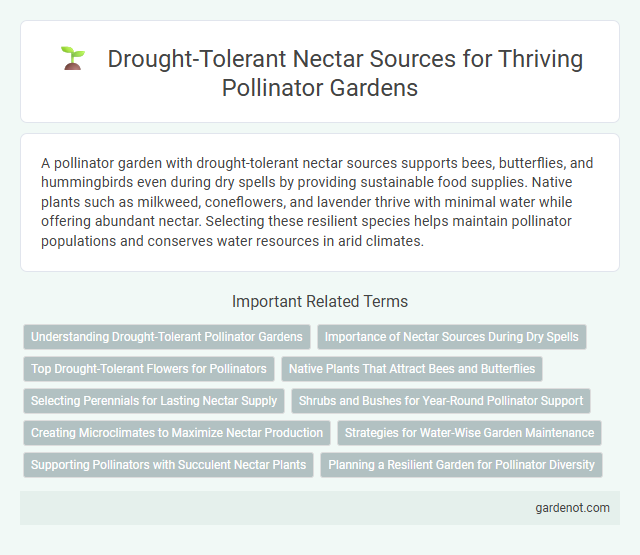A pollinator garden with drought-tolerant nectar sources supports bees, butterflies, and hummingbirds even during dry spells by providing sustainable food supplies. Native plants such as milkweed, coneflowers, and lavender thrive with minimal water while offering abundant nectar. Selecting these resilient species helps maintain pollinator populations and conserves water resources in arid climates.
Understanding Drought-Tolerant Pollinator Gardens
Drought-tolerant pollinator gardens utilize native plants such as milkweed, coneflowers, and lavender, which provide abundant nectar while requiring minimal water. These hardy species support bees, butterflies, and hummingbirds by blooming during dry periods when other flowers fail. Incorporating deep-rooted perennials and mulching techniques enhances soil moisture retention, ensuring continuous nectar supply even in drought conditions.
Importance of Nectar Sources During Dry Spells
Drought-tolerant nectar sources are crucial for sustaining pollinators during dry spells when water scarcity limits floral availability. Plants like lavender, salvia, and coneflowers provide consistent nectar that supports bees, butterflies, and hummingbirds despite arid conditions. Maintaining these resilient nectar sources enhances pollinator survival and promotes ecosystem stability in drought-prone areas.
Top Drought-Tolerant Flowers for Pollinators
Top drought-tolerant flowers for pollinators include coneflowers (Echinacea), blanket flowers (Gaillardia), and yarrow (Achillea), all known for thriving in dry conditions while providing abundant nectar. These resilient species support bees, butterflies, and hummingbirds by offering essential food resources during water-scarce periods. Incorporating drought-resistant plants enhances pollinator garden sustainability and ensures continuous nectar availability in arid climates.
Native Plants That Attract Bees and Butterflies
Native plants such as purple coneflower (Echinacea purpurea), bee balm (Monarda fistulosa), and butterfly milkweed (Asclepias tuberosa) provide drought-tolerant nectar sources essential for sustaining pollinators like bees and butterflies. These species thrive in low-water environments while supporting native pollinator populations by offering abundant, high-quality nectar throughout the growing season. Incorporating these native drought-resistant plants into a pollinator garden enhances biodiversity and promotes ecosystem resilience in arid or drought-prone regions.
Selecting Perennials for Lasting Nectar Supply
Choosing drought-tolerant perennials such as Echinacea purpurea, Salvia nemorosa, and Agastache species ensures a reliable nectar source throughout dry seasons, supporting pollinators like bees and butterflies. These resilient plants maintain bloom longevity and nectar production even under water-limited conditions, promoting sustainable pollinator habitats. Integrating deep-rooted, drought-resistant perennials enhances garden resilience while providing continuous foraging opportunities for native pollinators.
Shrubs and Bushes for Year-Round Pollinator Support
Drought-tolerant shrubs and bushes such as lavender, butterfly bush (Buddleja spp.), and manzanita provide essential year-round nectar sources for pollinators in arid climates. These resilient plants produce abundant flowers even during dry spells, supporting bees, butterflies, and hummingbirds with consistent nourishment. Incorporating native species like Russian sage and California lilac enhances garden sustainability while maximizing ecological benefits for pollinator populations.
Creating Microclimates to Maximize Nectar Production
Designing pollinator gardens with drought-tolerant nectar sources like lavender, salvia, and milkweed enhances resilience during dry periods by reducing water dependency. Creating microclimates through strategic plant placement, shading, and heat retention boosts nectar flow by moderating temperature and humidity around nectar-producing plants. These microclimates optimize floral nectar secretion, supporting pollinator health and increasing visitation rates in water-scarce environments.
Strategies for Water-Wise Garden Maintenance
Selecting native, drought-tolerant plants such as lavender, salvia, and yarrow ensures a consistent nectar source while minimizing water use. Implementing techniques like drip irrigation, mulching, and soil moisture monitoring optimizes water efficiency and supports pollinator health. Strategic timing of watering during early mornings or late evenings reduces evaporation, maintaining a sustainable pollinator garden ecosystem.
Supporting Pollinators with Succulent Nectar Plants
Drought-tolerant nectar sources like agave, aloe, and sedum provide essential nourishment for pollinators during dry conditions. These succulent plants retain water while producing abundant nectar that sustains bees, butterflies, and hummingbirds. Incorporating drought-resistant nectar plants enhances pollinator habitats by ensuring a reliable food supply in arid environments.
Planning a Resilient Garden for Pollinator Diversity
Drought-tolerant nectar sources such as native milkweed, coneflowers, and lavender provide essential nourishment for pollinators during dry spells, supporting a diverse ecosystem. Incorporating these resilient plants into pollinator gardens ensures continuous bloom cycles and sustains butterfly, bee, and hummingbird populations. Strategic selection of drought-resistant species reduces water use and enhances garden sustainability in arid and climate-variable regions.
Drought-tolerant nectar source Infographic

 gardenot.com
gardenot.com